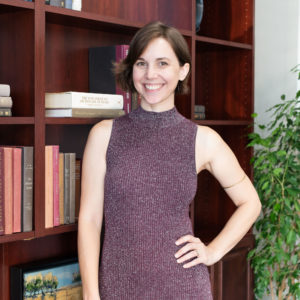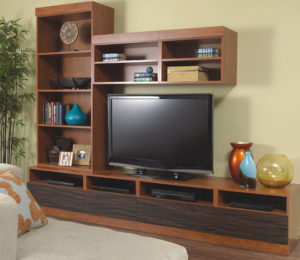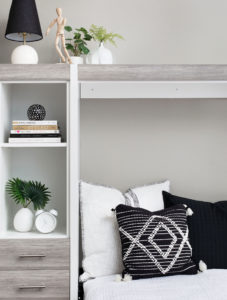
When you finish up a home project, the world is your oyster. You have beautiful new spaces to make your own.
If you’ve selected cabinetry or shelving to enhance your home, you can embrace these features and use them to give the room a distinct personality. When we work with clients to add new shelving features to their home, our designers can share plenty of ideas and wisdom about fully embracing and making use of the space.
We recently spoke with our More Space Place Austin showroom manager and stylist extraordinaire Cyndi Nevin about styling shelves and positioning your possessions so you can create that ideal “shelfie.”
Cyndi’s Top Six Tips for Beautiful Shelf Styling

Some of the top areas where new shelves might be added to a home include an updated guest suite; a media center; a home office; a laundry area; or a spacious new pantry. Even a custom closet may have some lovely open areas that are ripe for a stylish display.
While many of these spaces include shelves that aren’t visible to the public, the ones that are should be beautiful, so you enjoy looking at them and living with them every day.
If you have a More Space Place designer working with you, they’ll have plenty of ideas to get you started, and they’ll probably also include some iteration of these tips Cyndi shared with us.
1. Start big.

When you’re filling in a shelf, the best way to get started is to put in your biggest, must-have items. If you have a beautiful chinoiserie vase or a custom art piece, for example, you may want it to be an eyecatcher in your shelf layout.
Go ahead and find the right spot for that signature piece, then build the rest of your collection around it. You’ll find it easier to create stylish groupings when you have a centerpiece for each than when you are looking at a dozen different objects and make sense of them all in one go-round.
2. Use the Rule of 3.
 The Rule of 3 isn’t just an interior design rule – it’s science! According to researchers, odd numbers tend to be more pleasing to the eye because they’re asymmetrical and create visual interest.
The Rule of 3 isn’t just an interior design rule – it’s science! According to researchers, odd numbers tend to be more pleasing to the eye because they’re asymmetrical and create visual interest.
Aim for groupings of odd numbers. You don’t actually have to stick to three – five can work as well. Creating these small groupings can help you feel less stuck or overwhelmed when you’re pulling your shelf displays together.
3. Build your shelves around things you love.
 Marie Kondo recommends that you ask whether items spark joy as you decide whether to allow them space in your home.
Marie Kondo recommends that you ask whether items spark joy as you decide whether to allow them space in your home.
Cyndi very much agrees, saying that you should fill your shelves with the things that you love and that have meaning in your life. Instead of going out and buying picture perfect items or fashionable trinkets, look first at the things you already have that make you smile – things you want to enjoy each day, rather than items that may change as trends or decorative tastes transition.
- Do you smile every time you look at a vacation photo of your children or grandchildren?
- Does a treasured heirloom recall fond memories of a loved one?
- Do you need a little bit of greenery or plant life on display to make you feel at home?
For example, one client has a collection of handcrafted needlepoint pieces her mother made over her lifetime. She displays a few of her favorites on one of her media center shelves so she can enjoy them year round.
Think about what you’d want a visitor to know about you from looking at your shelves, then use that vision to “shop” around your home and make things personal. You’ll feel a little burst of joy every time you walk past them!
4. Have the supporting cast you need to make it work.
 Sometimes the pieces that you don’t see are just as important as the pieces you do see.
Sometimes the pieces that you don’t see are just as important as the pieces you do see.
You need a collection of tools and secret weapons to keep your items in place as you pull your shelves together. Cyndi’s must-have list for every project includes bookends, display stands and Fun-Tak.
Bookends hold things in place. Display stands allow you to show off items at their best angles. Fun-Tak is a mounting putty that holds items in place, so you can ensure your displays don’t shift or succumb to gravity over time.
5. You can never (well, almost never) have too many books.
 Books are often the first item people think about when it comes to shelving. However, filing up an entire shelf with books isn’t necessarily visually interesting – all lined up in a row with their spines out and taking up big blocks of space.
Books are often the first item people think about when it comes to shelving. However, filing up an entire shelf with books isn’t necessarily visually interesting – all lined up in a row with their spines out and taking up big blocks of space.
Thankfully, books are a lot more versatile than people think. Just shifting their positioning can give a shelf a whole new look. Try these options to give your shelves some literary visual appeal:
- Lay them on their sides individually
- Use them in stacks in place of bookends
- Let books create levels on your shelf, then use them as a base for other items on display
- Flip the spines to the back to allow other items to take the spotlight
- Display a book with an interesting cover facing front on a display stand
- Leave the book open to a fun page – like a beautiful illustration or quote
6. Don’t feel obligated to aim for minimalism.
 We asked Cyndi for her ideal shelf-to-stuff ratio as a way to ensure spaces aren’t getting overfilled or looking cluttered. Her reply: “The ideal shelf-to-stuff ratio is whatever your heart desires!”
We asked Cyndi for her ideal shelf-to-stuff ratio as a way to ensure spaces aren’t getting overfilled or looking cluttered. Her reply: “The ideal shelf-to-stuff ratio is whatever your heart desires!”
Whew – that’s a relief for all of the maximalists out there! Cyndi confessed to being a maximalist as well; at home, she uses her shelves to display the many treasures she’s accumulated over the years.
However, shelves can look great whichever way you lean. If you’re a minimalist at heart, prioritize the pieces that speak to you and clear away the rest.
You may also want to address this as you design your space. For example, if you’re a minimalist laying out a home office, consider adding more closed cabinet space instead of going for all open shelves.
Cyndi suggested creating shelf displays that incorporate your favorite things, then paring them down until they look just right and fit your personal preferences.
Cyndi’s Shelfie No-Nos
Cyndi believes almost anything in your home can find its own cohesive and harmonious space on your shelves. However, there are a few items she sees often in people’s decorating that could be better stored out of the spotlight.
Some of the specific items on her list included:
- Tissue boxes – People often throw tissue boxes into themix on their shelves because they want to keep them somewhere convenient. It’s not particularly attractive to be reminded of sniffles and sneezes when you’re looking at your otherwise well-appointed shelves. It’s also not convenient when you have to rearrange your décor to accommodate every household cold!
- Branded candles – If you want to include candles in your shelf design, feel free to do so. Branded ones with designs on their labels can be a distraction, though. Aim for candles in pretty decorative containers without distracting nametags or images.
- Dust – Everything looks more attractive when it’s sparkling and clean. As you choose items for your shelves, consider how much they might trap dust or how much effort it might take to keep them clean. Items with a dozen little nooks and crannies may be beautiful (think cut-glass crystal decanters or pottery with a lot of ridges), but if you don’t have the time to get into all those crevices, you may rethink displaying them prominently.
- (Some) plants – Greenery can be a lovely addition to a shelf. However, take some time to consider the type of plant you’ll display. If your shelves get direct sunlight, you may have a wider variety of plants available to you. If they’re not exposed to much like, you may need to shift your expectations, choosing succulents or high-quality silk plants as alternatives.
Cyndi’s Shopping List
 Wondering where Cyndi shops for her favorite shelfie accessories? In her opinion, your first shopping stop should be your own home. “I’m a big believer that a home should be a reflection of the lives of those living in it,” Cyndi said. “Everyone has things that are special and important to them, and these are the items they should use to fill their space.”
Wondering where Cyndi shops for her favorite shelfie accessories? In her opinion, your first shopping stop should be your own home. “I’m a big believer that a home should be a reflection of the lives of those living in it,” Cyndi said. “Everyone has things that are special and important to them, and these are the items they should use to fill their space.”
When she does look for something new to add some visual dimension to a shelf, some of her favorite shopping spots include At Home, HomeGoods, CB2, and West Elm. When she’s working with a client, she can usually score enough stylish finds from those four stores to fill the gaps throughout an entire house.
Getting your shelves in order – that’s the fun reward at the end of a great project. If you’re just getting started, you have the opportunity to lay a great foundation and create spaces that form a perfect canvas for your artistic vision.
And we’re here to help – our team works with clients from brainstorming to design to implementation in order to make sure you’ve put together a space that’s perfect for you. Stop by our showroom, meet our team of designers and get some inspiration from our shelf designs, roomscapes and more.




